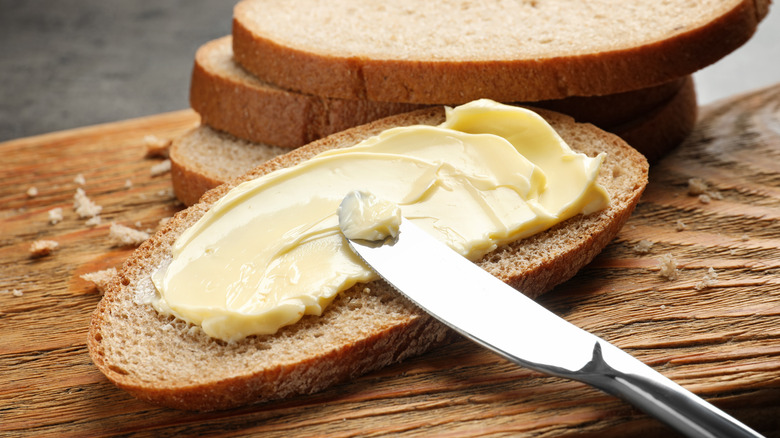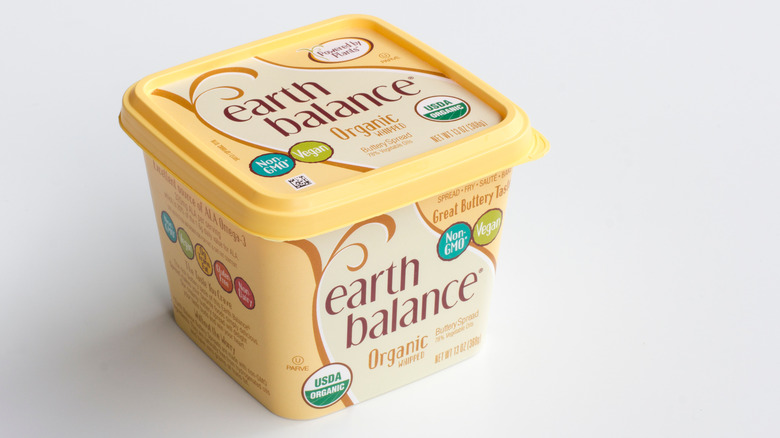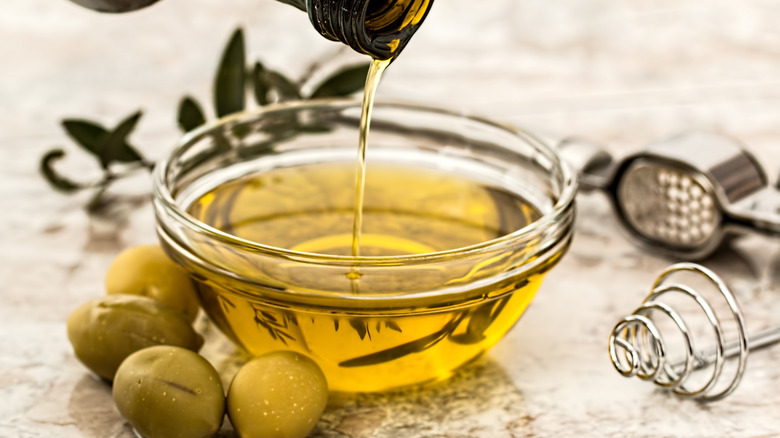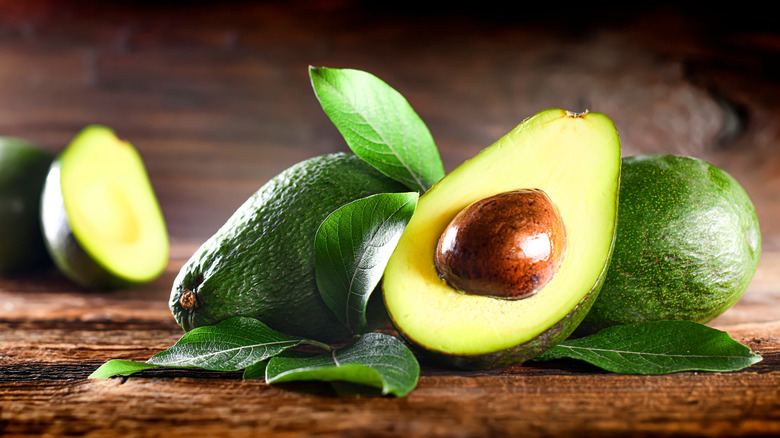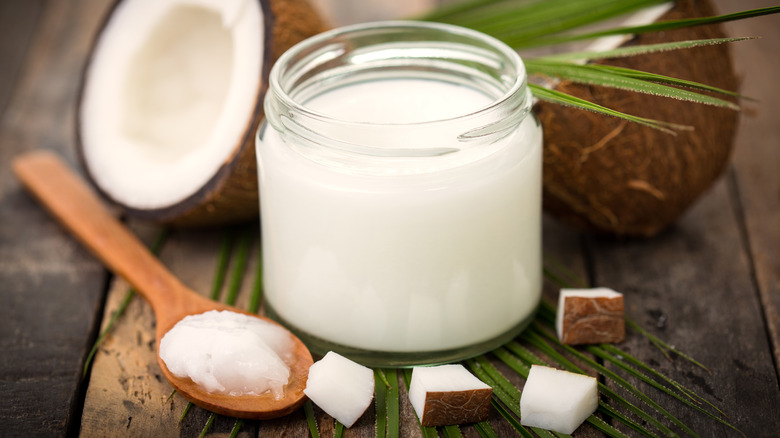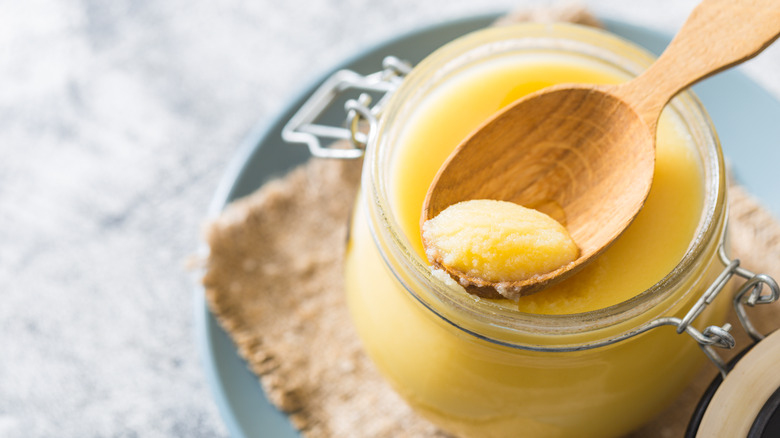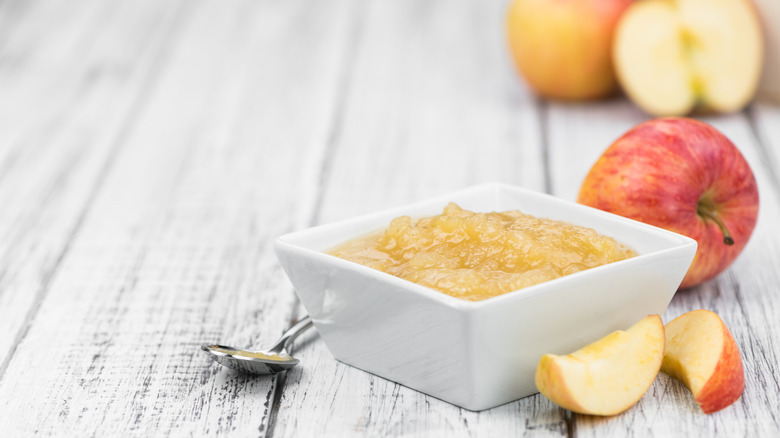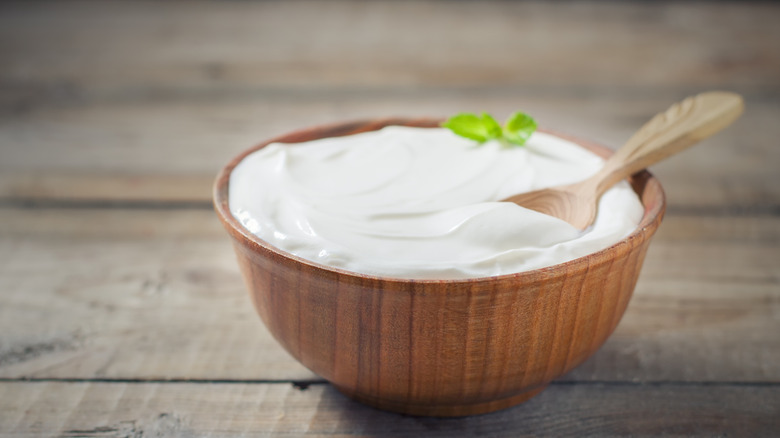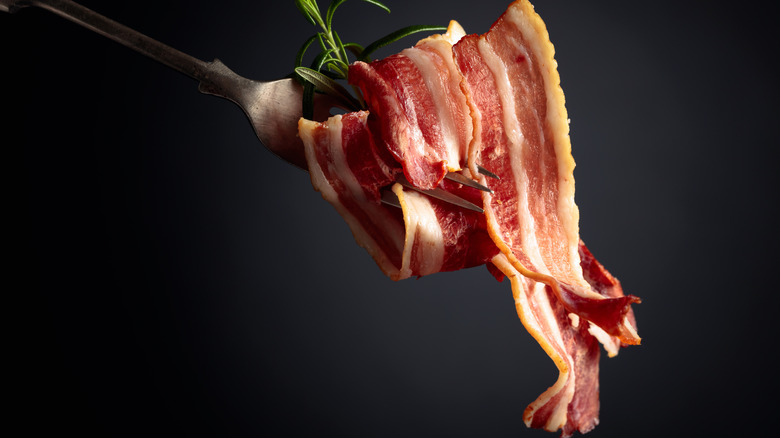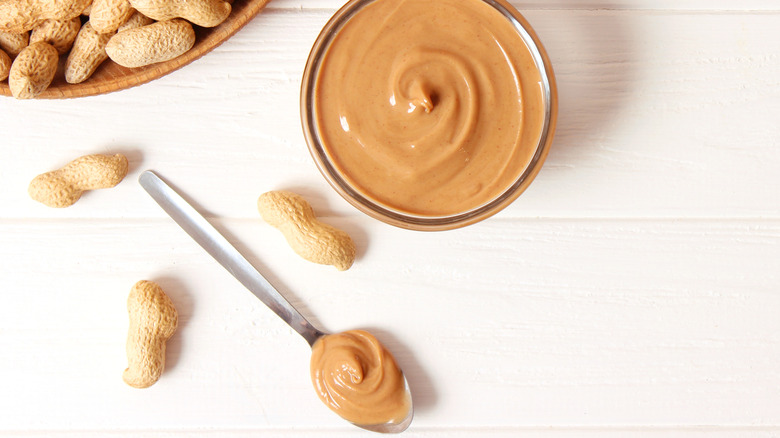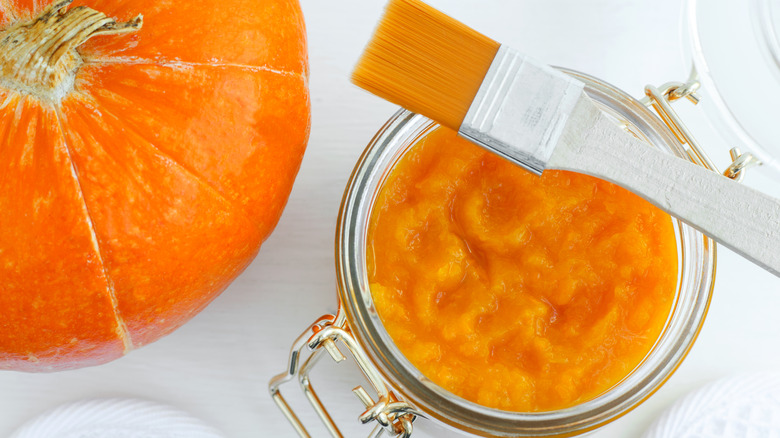10 Best Substitutes For Butter
It's hard to beat butter. What else can you say is used in baked potatoes, cakes and cookies, roasted asparagus, toast, popcorn, and steak? Butter is useful, versatile, and delicious. But butter isn't all that healthy. Plus, some people need to or choose to avoid dairy, and in other cases, you simply may run out of butter in the course of your cooking.
So what's to be done when you don't have any butter on hand? Give up and throw that half-finished batch of brownies out the window? Suffer through a plate of dry, boring toast or bagels? Dump A.1. on your ribeye and rob the steak of its flavorful potential? No! Not when there are so many great substitutes for butter. Whether you are avoiding butter for dietary or personal reasons or you just don't have any butter in the kitchen, below you will find no fewer than 10 great options you can use in place of this creamy spread.
Just note that not all butter substitutions serve the same purposes — while bacon fat may be an ideal stand-in for butter when sautéing vegetables, for example, you'll want to skip it when baking brownies. Once you get to know these 10 butter substitutes, you'll know exactly what to turn to no matter what you're making.
1. A dedicated butter substitute
A generation back, you didn't have many choices when it came to butter alternatives. There was "I Can't Believe It's Not Butter," shilled for by heartthrob Fabio, and that was about it (via YouTube). I Can't Believe It's Not Butter and the few other brands of nondairy butter alternative available in decades past were essentially just different formulas of margarine, a spread primarily consisting of fatty vegetable oils mixed with water.
Today, you have many more options for non-dairy "butters" from brands like Earth Balance, Forager, Smart Balance, and others. The primary ingredient is still usually a vegetable oil, but you will also find ingredients like pea protein and sea salt, and the taste of many current buttery spreads really do create an amazing verisimilitude of real butter.
Best of all, a non-dairy butter substitute can be used as a direct one-for-one swap for butter without any changes to the recipe or cooking process.
2. Olive oil
Olive oil is a great substitute for butter in many recipes. Because it is one of the healthier oils out there, it can not only allow you to move ahead with your cooking when you run out of butter, but it can make your dish better for you, too. Olive oil can be swapped in for butter in almost every culinary use: baking, sautéing, preparing a meat or veggie for roasting or grilling, the list goes on.
However, being a liquid, olive oil is not a perfect sub for butter. It's not going to spread well on toast or bagels, for example (though bread dipped in olive oil is superb) and it can't be used in things like an icing or some sauces, where consistency plays a key role. Those minor caveats aside, olive oil is a great shelf-stable butter substitute that you will usually have on hand.
To substitute olive oil for butter, go with a 3:4 ratio, according to Healthline, meaning that a recipe calling for one cup of butter should be made with ¾ cup of olive oil. For situations where you'd use melted butter, like cooking in a pan or coating meat or vegetables to be roasted or grilled, it's OK to eyeball it a bit with the oil.
3. Avocado
You'll be surprised how well a perfectly ripe avocado can stand in for butter. It works great spread on all sorts of breads, bagels, or rolls (thus the whole avocado toast sensation), it can be used in baked goods like brownies or cookies and sweet dishes like pudding. Plus, it adds healthy fats.
Just be sure to slightly reduce oven temperatures when using avocado instead of butter to avoid the food browning or burning too easily — The Kitchn recommends a reduction of 25 degrees; you can increase the cooking time to compensate if needed. Avocado won't melt into a liquid, so it can't be used for things like sautéing or coating a foodstuff. The only other issue with avocado is that unlike butter, it does not keep well, so having one at the ready can be hard. Due to this, using avocado instead of butter has the potential to shorten the "lifespan" of a finished dish.
When substituting avocado for butter, you simply use a direct one-for-one swap of mashed (or better yet, pureed) avocado used in lieu of butter, according to California Avocados.
4. Coconut oil
Coconut oil is a great stand in for butter, largely because its physical properties are very similar. When chilled, coconut oil is firm enough to be sliced and cut into very specific measurements. At room temperature, coconut oil is soft enough for easy scooping and spreading. And when heated, coconut oil readily melts, making it great to mix in with the dry ingredients of a cake batter, to use in stir frying some chunks of pork, and everything in between.
The only real issue with coconut oil is the fact that it can have a strong coconut flavor. That can be a great thing in baked goods or sweeter dishes, but a real problem in something that definitely doesn't call for a sweet, tropical taste, like a pan of roasted Brussels sprouts or a seared salmon fillet.
But there's a way around that: refined coconut oil. The more heavily refined the coconut oil, the less coconut taste it will have, and the less flavor it will impart into your cooking.
Whether solid, softened, or melted, you can use coconut oil as a one-for-one substitute for butter.
5. Ghee
What is ghee, you ask? It's simply clarified butter. And alright, what is clarified butter? It is, according to Land O Lakes, butter that has had the milk solids and water removed, leaving behind only pure butterfat. It is made by slowly heating butter and skimming off the foam, then straining the remaining liquid to remove the milk solids.
It's great for pan frying or high heat roasting as it has an even higher smoke point than regular butter, but note that the flavor of ghee is more intensely buttery than the taste of classic butter, so consider reducing the quantity used a bit if you worry the taste may overwhelm other ingredients.
Because ghee/clarified butter is really just a type of butter, it can be used in all sorts of recipes that call for butter in a direct swap ratio. One other thing to note about ghee: it can usually be stored for quite a long time even without refrigeration, provided you can store it in a cool and dark place.
6. Applesauce
It might seem odd, but yes, you can replace butter with applesauce in many recipes. (Stranger still? You can use applesauce to replace eggs in many recipes, too.) Now of course you would be ill-advised to use applesauce in place of butter for stir frying, but for other purposes, such as baking, it's a great substitution.
Because applesauce is so moist, it's a good idea to use a reduced amount of the stuff when it is standing in for butter. In fact, according to Bob's Red Mill, you should use only use about half as much applesauce as butter in most baked goods — and indeed it is in baking where applesauce makes a good stand-in for butter. If you want a rather moist, dense bread, applesauce can be even better than butter. But of course, it will impart a bit of an apple taste and a sweetness (unless you opt for an unsweetened or even a homemade option).
7. Greek yogurt
There are many creative ways to use Greek yogurt, and a butter substitute is one of them. Livestrong suggests using a nonfat, unflavored Greek yogurt if you want a butter stand-in that won't much change the way your dish tastes, but generally speaking, it's a good substitute for use in muffins, cakes, brownies, and more.
Greek yogurt can make a finished baked good a bit too moist in some cases. But rather than scaling back on how much of it you use, instead consider a slight increase to the dry ingredients, adding about an extra ¼ cup of flour per every cup of Greek yogurt you use during baking, for example. And for the record, don't try to substitute Greek yogurt for butter in any kind of pan cooking, grilling, or roasting — that won't work out as well.
In many recipes, primarily when you are baking, you can use Greek yogurt in place of butter in a direct one-for-one swap, according to Livestrong.
8. Bacon fat
Bacon fat, which may accurately also be called bacon grease, may not sound like the most delectable or versatile item. But let's be honest: it's both. While hardly healthy, bacon fat is truly delicious, imparting a rich, savory taste to anything from pan fried veggies to seared steaks. You can use bacon grease in place of butter in all sorts of recipes, from cooking a traditional breakfast meal to making biscuits and/or gravy to use in various savory baked goods.
Whether you collect your own bacon grease after frying up a few rashers of bacon or you opt for store-bought bacon grease, it is a stable ingredient that will keep for months in the fridge. Just make sure you give it some time to come back up to room temperature or heat the stuff up before you start cooking with it, and do use care when cooking with bacon fat atop the stove: those spatters of hot bacon grease can be a genuine mess and a real pain.
You can use bacon grease in place of butter in all sorts of recipes, from cooking a traditional breakfast meal to making biscuits and/or gravy to use in various savory baked goods. MyRecipes notes you can use the same amount of bacon grease as you would butter.
9. Peanut butter
Peanut butter can be used as a stand-in for butter in lots of recipes provided you also have another ingredient on hand: an oil. This is because while butter is almost all fat, peanut butter (and other nut butters) also have a lot of protein, so by adding the oil, you make a more similar foodstuff.
This peanut butter and oil blend is a great choice for sweet baked goods like brownies or cookies and will add even more richness and flavor than the butter would have. It can even be delicious with proteins like chicken or tofu, in the way a Thai peanut sauce is. However, it is not suitable for use in stovetop cooking or savory dishes with flavors that would clash with peanut butter.
When using peanut butter as a sub for regular butter, you want to first make a 50:50 blend of peanut butter and a vegetable oil (like a basic canola oil or an avocado oil). You can then use this blend as a substitute for regular butter on a one-to-one basis, according to Leaf.
10. Pumpkin puree
Pumpkin puree is another ingredient that's a great swap for butter in some recipes, but certainly not all of them. For baking a loaf of tasty sweet bread or a dozen cookies, pumpkin puree is a great substitute for butter. For sautéing shrimp? Not so much. So be selective when using pumpkin puree instead of butter in your cooking, but don't hesitate to experiment. Seeing as you can keep cans of pumpkin puree in the pantry for as long as five years, according to Leaf, you can always have some of it at the ready.
Healthline calls the stuff "a nutrient-rich butter replacement" and recommends using about ¾ the amount of pumpkin purée as butter. Pumpkin puree is a great way to reduce the fat content of a dish and add some extra vitamin A, vitamin C, copper, iron, and potassium to your diet.
